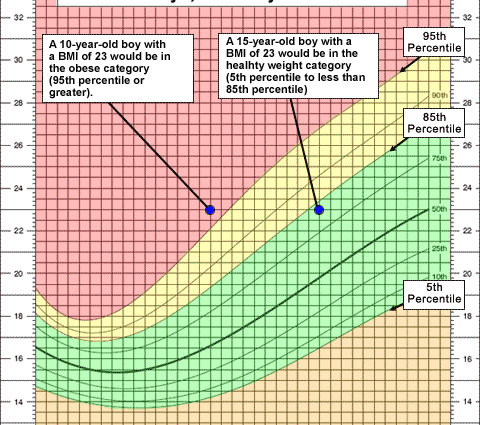Contents
Excess weight is often overlooked in young children. Parents generally rely on the eye to estimate the ideal weight for their baby. However, there are tools such as the body curve, which can detect weight gain, or even the onset of obesity from early childhood.
Boy and girl BMI: calculation and interpretation
The calculation of BMI in children is the same as for adults. Just divide the weight (in kilograms) by the height squared. Note that special discs, available in particular from the doctor, can quickly indicate the BMI of a child.
BMI = weight ÷ (height) 2
Be careful, you must use the size in meters and not in centimeters. For example, for a child who measures 1 meter 10 you should use 1,10 meters for the height and not 110 centimeters. For a child who is 60 centimeters tall, 0,60 meters should be used.
Even if the formula is the same as for adults, the interpretation of the result is different. In children, the reference values vary according to age and sex. These are plotted on a percentile curve called the “corpulence curve”, which makes it possible to assess the nutritional status of the child. When the BMI is above the 97th percentile, the child is considered obese. On the other hand, if their BMI is below the 3rd percentile, the child is underweight.
The evolution of the child’s weight curve. What weight at what age?
The size of the child increases the first year of growth then decreases until the age of 6 years to go up gradually. The reversal of the BMI curve is called the ‘fat rebound’. The age of the onset of this curve rebound is considered to be a real marker, which can give warning in the event of the development of obesity. In fact, the earlier the rebound in adiposity (before 5-6 years), the more the risk of obesity increases.
The corpulence curve is present on the children’s health record. It can also be downloaded from the website of the Ministry of Health or that of the National Institute for Prevention and Education for Health (INPES), or even built automatically using the Calimco software.
What if the child’s BMI is not normal?
Unfortunately, the body curve is not always drawn during medical consultations. However, monitoring children’s BMI remains very important to help detect children at risk of being overweight or obese, and thus facilitate their care. It is therefore recommended that parents remain attentive to their child’s weight and discuss it with the doctor. You should know that the child’s BMI is not stable, because as they grow older, their curve changes.
If in doubt, or if you think your child is overweight, talk to your doctor or pediatrician who will advise you on what to do next. It is important not to put a child on a diet without the prior advice of a health professional.
Child’s BMI: latest recommendations
As for adults, BMI in children remains a purely theoretical assessment tool.. It is therefore necessary to have the result analyzed by a doctor. There may be a difference from the norm that will not affect your child’s health. Because the figure is not the only indicator, other factors linked in particular to the ethnic and family context of the child come into play for the interpretation of the BMI. It is therefore once again up to the doctor to take stock.
However, it is recommended to regularly monitor a child’s BMI to prevent the risk of overweight and obesity. Good reflexes such as rebalancing eating habits and fighting a sedentary lifestyle can reverse the trend in case of imbalance.
Source: National Institute for Prevention and Health Education (INPES)
Do not hesitate to bring the body curve to your doctor or pediatrician during consultations. He will be able to advise you and inform you about the daily behaviors conducive to a good evolution of your child’s BMI.











Pozdrav! Ja sam cura od 9 godina i 8 mjeseci, imam 132.8 cm i 35.8 kg. Jače sam konstitucije. Ja za sebe mislim da sam premršava i preniska za svoju dob, a kada sam bila mala imala sam problema sa neuhranjenošću i imala sam svega 15 kg u prvom razredu, i 114 cm. Zadnjih 6-8 mjeseci mi je ostala posljedica svih tih nalaza i ruganja prijatelja i počela sam se jako često, i više nego prejedati. Idem spavati čim zađe sunce, i tijekom škole sam se budila oko 5:30, ali sada u podne, jako sam odmorna. Imam umjerenu zdravu mišićnu masu i imam prečeste i preredovite visokokalorične i kaloričnije obroke sa puno zdrave masti, bjelančevine, ugljikohidrata, proteina, povrća, voćne salate, vitamina, minerala…uključujući isto tako i još redovotije i još češće zdrave međuobroke, u kojima jedem orašasto voće, avokado, voće, navečer nakon večere i svježe i čokoladno mlijeko, kakao i pomiješani kajmak, sir i vrhnje uz puno špeka. Često popijem i proteinski smoothie. Fizički jako aktivna i jedna od najjačih u razredu. Ali, samo me zanima da li sam ja premršava?